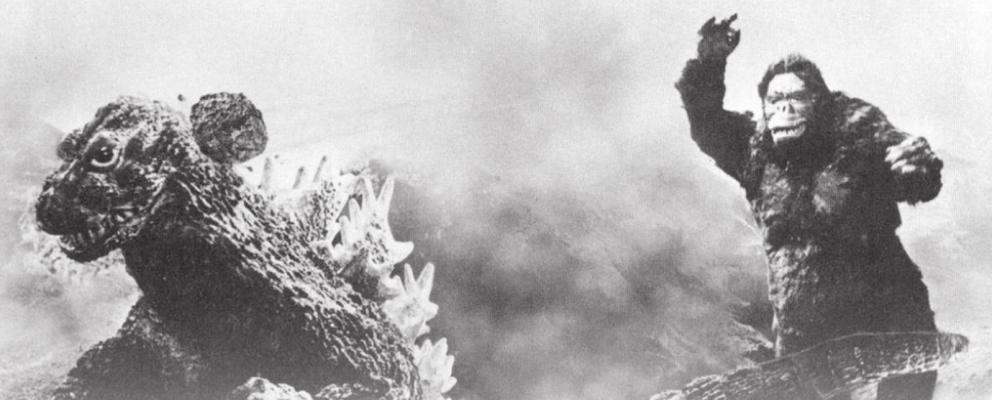The Original KING KONG VS. GODZILLA
So literally the day after my first column about Godzilla vs. Kong, the trailer for the movie drops and it was trending at number one for a good 48 hours, so clearly, other people are as excited for the film as I am.
So to ride this hype train, lets take a look at the original 1962 film featuring these two titans of the silver screen: King Kong vs. Godzilla.
The plot sees the head of a pharmaceutical company frustrated with the shows his company is sponsoring and is looking for something to boost ratings. He sends two men to Faro Island in search of the mythical monster that lives there…King Kong.
Meanwhile, an American submarine is investigating a mysterious rise in sea temperatures and gets caught in an iceberg containing Godzilla (Godzilla was previously trapped in said iceberg in Godzilla Raids Again.) The two monsters then run amok in Japan and head towards their climactic battle at the summit of Mount Fuji.
The film was the first to feature both Godzilla and Kong in color and saw the return of the quartet of Godzilla creators (Director Ishiro Honda, Special Effects Director Eiji Tsuburaya, Producer Tomoyuki Tanaka and Composer Akira Ifukube).
The film’s history is an interesting one tied up in a lot of legal issues and gray areas that could make up and entire column on their own.
Willis O’Brien, the stop motion animator on the original 1933 King Kong, had written a story treatment for a follow up to King Kong that would see Kong face off with a giant monster created by Dr. Frankenstein. This treatment was sold to independent producer John Beck and it was fleshed out into a screenplay by the name of King Kong vs. Prometheus (a reference to the original Frankenstein novel).
Beck approached Toho to produce the film, and they reworked the script to include Godzilla as Kong’s opponent. The film was released for the studio’s 30th anniversary celebration.
To make Kong more of a match for Godzilla, his size was increased to 45 meters to match Godzilla’s height of 50 meters. Furthermore and possibly a hold over from the old script, electricity made Kong stronger.
Special Effects Director Eiji Tsuburaya had initially desired to use stop motion for the film, but it proved too expensive and instead chose to utilize suitimation that was pioneered in the first two Godzilla films.
The Godzilla suit for this film, called KingGoji by fans, was altered from Godzilla’s previous appearances to be more reptilian and bulkier. Godzilla is portrayed by Haruo Nakajima who played the character in every Godzilla film from 1954 to 1972, and this suit is one of the more famous and well received suits in the series.
The Kong is…not as good. The Kong suit suffers from a rather unconvincing look and is unfortunately rather cheap looking next to Godzilla.
A third monster appearing in the film, a giant octopus, was portrayed by the use of four live octopuses moving around a miniature set. Three of the four were released and the fourth became Tsuburaya’s dinner, making this the only time I can recall an effects director eating one of his special effects.
The film was altered for its US release with many new scenes added in the style of a news broadcast featuring a United Nations reporter. Additionally, the Japanese score was largely replaced with stock music from Universal films such as Creature from the Black Lagoon and The Wolf Man.
For years there were myths about dual endings for the film. According to the myth, King Kong won in the US version of the film and Godzilla won in the Japanese version. The truth of the matter is that King Kong wins in both versions after the monsters fall off a cliff into the ocean and Kong is the only one to surface. The only real difference between the two versions is the roars that occur at the end title. In the US version, only Kong’s roar is heard, and in the Japanese version both monsters are heard.
The US version of the movie is the one that is most widely available to the public, but in 2019, Criterion managed to release the original Japanese version along with the 14 other Showa era Godzilla films from 1954 to 1975.
It should be noted that the Japanese version of the film isn’t in the best of conditions. This was mostly due to edits done to the original negative of the film. Director Ishiro Honda had cut 24 minutes from the film so that it could be shown at the Toho Champion Film Festival, which was a children’s matinee featuring cartoons and kaiju films. As a result, the highest quality source for the film was lost.
So there is a rather long winded look at the first bout between Godzilla and King Kong. The newest movie seems to be garnering quite a lot of attention and after nearly 50 years we’ll finally get another match between these two titans of the screen.


